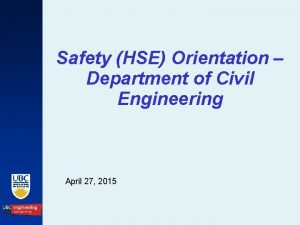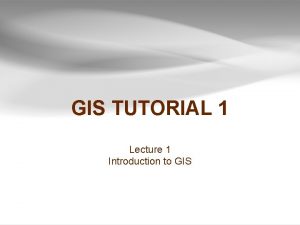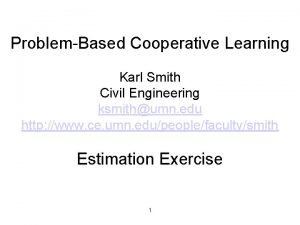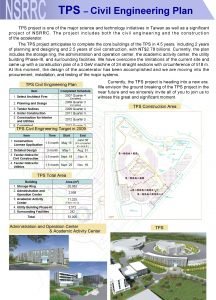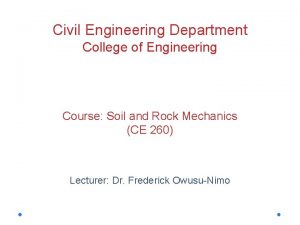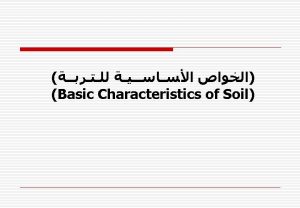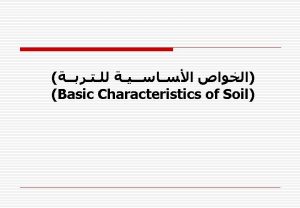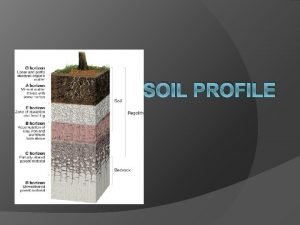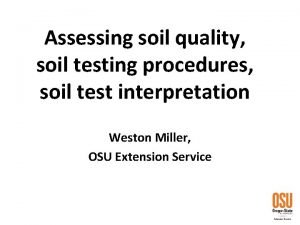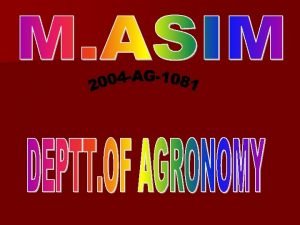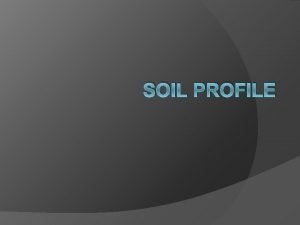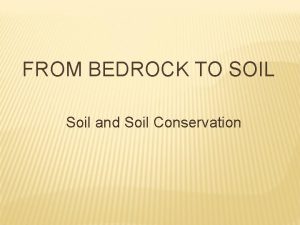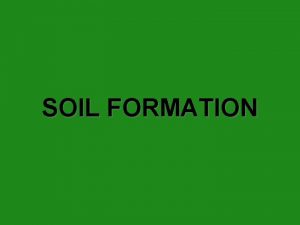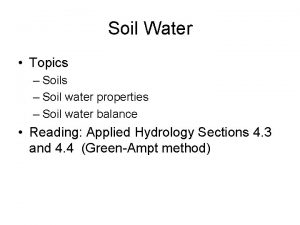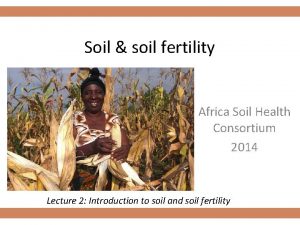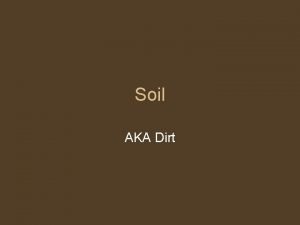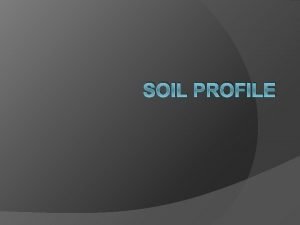Civil Engineering Department College of Engineering Course Soil



































- Slides: 35

Civil Engineering Department College of Engineering Course: Soil and Rock Mechanics (CE 260) Lecturer: Dr. Frederick Owusu-Nimo

Soil type based on Particle Size Designation Category Particle Size (mm) Boulders > 200 Cobbles 60 - 200 Gravel Coarse Medium Fine 20 – 60 6 – 20 2 - 6 Sand Coarse Medium Fine 0. 6 – 2 0. 2 – 0. 6 0. 06 – 0. 2 Silt Coarse Medium Fine 0. 02 – 0. 06 0. 006 - 0. 02 0. 002 -0. 006 Clay Fine < 0. 002

Soil type based on Particle Size Cobbles 60 -200 mm Boulders > 200 mm Gravels 2 -60 mm

Determination of PSD ? Sieve Analysis

Sieves commonly used BS Sieve Designation ASTM Designation Aperture 1 in ¾ in ½ in 3/8 in ¼ in 3/16 in No. 7 No. 14 No. 25 No. 36 No. 52 No. 72 No. 100 No. 200 0. 53 in 3/8 in 0. 265 in No. 4 No. 8 No. 16 No. 30 No. 40 No. 50 No. 70 No. 100 No. 200 26. 5 mm 19. 0 mm 13. 2 mm 9. 5 mm 6. 7 mm 4. 75 mm 2. 36 mm 1. 18 mm 600 μm 425 μm 300 μm 212 μm 150 μm 75 μm

Sieve Analysis (Stack of Sieves)

Example An air dry soil sample weighing 2000 g is brought to the soils lab for mechanical grain size analysis. The lab data are given in the table. US Sieve Analysis ¾ in 3/8 in No. 4 No. 10 N 0. 40 No. 100 No. 200 Pan Size Opening 19. 0 (mm) 9. 5 4. 75 2. 0 0. 425 0. 150 0. 075 - Wight Retained 0 (g) 158 308 652 224 42 8

Example US Sieve Analysis ¾ in 3/8 in No. 4 No. 10 N 0. 40 No. 100 No. 200 Pan Size Opening 19. 0 (mm) 9. 5 Wight Retained 0 (g) 158 4. 75 2. 0 0. 425 0. 150 0. 075 - 308 652 224 42 8 % Retained 0 7. 9 15. 4 30. 4 32. 6 11. 2 2. 1 0. 4 Cumulative % Retained 0 7. 9 23. 3 53. 7 86. 3 97. 5 99. 6 100 % Passing 100 92. 1 76. 7 46. 3 13. 7 2. 5 0. 4 -

Determination of PSD Hydrometer Analysis Sieve Analysis

Hydrometer Analysis

Features of PSD Curve

Features of PSD Curve

Nature of PSD Curves Well Graded Uniform Graded Gap Graded Soil A Soil C Soil B Poorly Graded

Atterberg Limits

Atterberg Limits • Shrinkage Limit (SL): Water content below which no further volumetric change takes place as soil is dried • Liquid Limit (LL): Water content beyond which soil flows under a specified small force • Plastic Limit (PL): Water content beyond which plastic deformation can be initiated. Minimum water content at which soil can be rolled into a thread 3 mm thick • Plasticity Index: Range of water content over which soil remains in plastic condition. PI = LL – PL • Liquidity Index (LI): Indicate nearness of a natural soil to the liquid limit • Activity of Clay: Index for identifying the swelling potential of clay soils. Higher activity implies higher swelling potential.

Atterberg Limits Typical Values of LL and PL for some common clay minerals Clay Mineral Kaolinite Illite Montmorillonite Liquid Limit 35 -100 55 -120 100 -800 Plastic Limit 20 -40 35 -60 50 -100 Activity 0. 3 – 0. 5 – 1. 2 1. 5 – 7. 0

Atterberg Limits

Soil Classification System • A universal language where soils of similar behavior are grouped together, and systematic and rational ways are proposed to classify and describe them. • Classification based on PSD and Atterberg limits • Can provide geotechnical engineers a general guidance about engineering properties of the soils through the accumulated experience • Can be used to solve many types of simple foundation problems without need for in depth investigations • Can be used to guide a test program in case of in depth investigations

Soil Classification System • Common classification systems for engineering purposes o Cassagrande Extended Soil Classification System o The Unified Soil Classification System o The American Association of State Highway and Transport Officials (AASHTO) Soil Classification System

Cassagrande’s Extended Soil Classification System • Use PSD and Atterberg Limits • Two main soil groups: Coarse grained and fine grained • Soils classified using two letters (Prefix and Suffix) • Suffix – related to the • Prefix –based on engineering properties predominant particle o W: Well-graded size o o o G: S: M: C: O: Gravel Sand Silt Clay Organic o o o P: Poorly-graded H: High plasticity (LL>50%) L: Low plasticity (LL<35%) • e. g. : GW, SP, CH GW = Well graded gravels

Cassagrande’s Extended Soil Classification System For Coarse Grained Soils (< 50% fines) • Prefix G: Gravel (predominant size > 2 mm) o o S: Sand (predominant size < 2 mm) • e. g. : GW, GP, SF • Suffix o W: Well-graded o U: Uniform material o P: Poorly-graded o C: Well graded with some clay o F: Well graded with excess of fines

Cassagrande’s Extended Soil Classification System For Fine Grained Soils (> 50% fines) • Prefix C: Inorganic Clay (Plasticity above A line) o o M: Silt (Plasticity below A line) o O: Organic Clays(Plasticity below A line) • Suffix o H: High Plasticity(LL>50%) o I : Intermediate Plasticity (35%<LL<50%) o L: Low Plasticity(LL<35%) • e. g. : CH, ML, CL

Unified Soil Classification System • Similar to the Cassagrande’s Classification System • Uses grain size distribution and Atterberg limits for classification • Commonly used for engineering projects • Soils are grouped into o Coarse grained o Fine grained o Highly Organic Soils

Unified Soil Classification System 50 % Coarse-grained soils: Gravel Sand >50% NO. 4 4. 75 mm Fine-grained soils: Silt Clay NO. 200 0. 075 mm • Grain size distribution • C u • C c • PL, LL • Plasticity chart

Unified Soil Classification System • Soil symbols: • G: Gravel • S: Sand • M: Silt • C: Clay • O: Organic • Pt: Peat Example: SW, Well-graded sand SC, Clayey sand SM, Silty sand • Liquid limit symbols: • H: High Plasticity (LL>50) • L: Low Plasticity (LL<50) • Gradation symbols: • W: Well-graded • P: Poorly-graded

Classification Procedure Coarse-grained material Grain size distribution Fine-grained material LL, PI Highly (Santamarina et al. , 2001)

Example Passing No. 200 sieve 30 % LL= 33 Passing No. 4 sieve 70 % PI= 12 Passing No. 200 sieve 30 % Passing No. 4 sieve 70 % LL= 33 PI= 12 PI= 0. 73(LL-20), A-line PI=0. 73(33 -20)=9. 49 SC ( 15% gravel) Clayey sand with gravel Highly 27

Organic Soils • Highly organic soils- Peat (Group symbol Pt) A sample composed primarily of vegetable tissue in various stages of decomposition, a dark-brown to black color, and an organic odor should be designated as a highly organic soil and shall be classified as peat, Pt. • Organic clay (group symbol OL or OH): “The soil’s liquid limit (LL) after oven drying is less than 75 % of its liquid limit before oven drying. ” If the above statement is true, then the first symbol is O. The second symbol is obtained by locating the values of PI and LL (not oven dried) in the plasticity chart.

Borderline Cases (Dual Symbols) • A dual symbol is used for the following conditions o. Coarse-grained soils with 5% - 12% fines. - About 7 % fines can change the hydraulic conductivity of the coarse-grained media by orders of magnitude. - The first symbol indicates whether the coarse fraction is well or poorly graded. The second symbol describe the contained fines. For example: SP-SM, poorly graded sand with silt. o. Fine-grained soils with limits within the shaded zone. (PI between 4 and 7 and LL between about 12 and 25). - It is hard to distinguish between the silty and more clay like materials. - CL-ML: Silty clay, SC-SM: Silty, clayey sand. o. Soil contain similar fines and coarse-grained fractions. - possible dual symbols GM-ML

Borderline Cases (Summary) (Holtz and Kovacs, 1981)

The AASHTO Classification System • The American Association of State Highway and Transportation Officials system (AASHTO) classification system is widely used for highway (road) work. • The required parameters are grading curve, liquid limit and plastic limit. • Soils divided into 8 major groups: A 1~ A 7 (with several subgroups) and organic soils A 8. A 1 ~ A 3 Granular Materials 35% pass No. 200 sieve A 4 ~ A 7 Silt-clay Materials 36% pass No. 200 sieve

The AASHTO Classification System • The group index (GI), an empirical formula, is used to further evaluate soils within a group (subgroups). The first term is determined by the LL The second term is determined by the PI • GI rounded off to the nearest whole number and appended in parenthesis • If GI = 0 or negative; then GI = 0 • In general, the rating for a pavement subgrade is inversely proportional to the GI (lower the GI, better the material).

Classification – Granular material Das, 1998

Classification- Silt clay material Note: The first group from the left to fit the test data is the correct AASHTO classification. Das, 1998

Example % Passing No. 200 86% % Passing No. 200; 86% LL=70, PI=32 LL-30=40 > PI=32 Round off A-7 -5(33)
 Civil rights webquest
Civil rights webquest Living soil vs dead soil
Living soil vs dead soil What are the four spheres of the earth
What are the four spheres of the earth National civil defence college
National civil defence college T junction of stretcher bond
T junction of stretcher bond Course title and course number
Course title and course number Course interne moyenne externe
Course interne moyenne externe Pasadena city college police department
Pasadena city college police department Master of civil engineering unsw
Master of civil engineering unsw Hse orientation
Hse orientation Civil engineering insurance policies
Civil engineering insurance policies Applications of grouting
Applications of grouting What is formwork in civil engineering
What is formwork in civil engineering Introduction to civil engineering
Introduction to civil engineering Role of civil engineering
Role of civil engineering Gis applications in civil engineering
Gis applications in civil engineering Czech technical university in prague civil engineering
Czech technical university in prague civil engineering Civil engg drawing house planning
Civil engg drawing house planning Bisection method application in civil engineering
Bisection method application in civil engineering Umn civil engineering
Umn civil engineering Ndsu industrial engineering
Ndsu industrial engineering Mass concrete retaining wall
Mass concrete retaining wall What is roominess in civil engineering
What is roominess in civil engineering Civil engineering applications of ground penetrating radar
Civil engineering applications of ground penetrating radar Integrated design project civil engineering
Integrated design project civil engineering Civil engineering faculty
Civil engineering faculty Ub course flowsheet
Ub course flowsheet Cuban american association of civil engineers
Cuban american association of civil engineers Branch of civil engineering
Branch of civil engineering What is specific gravity of concrete
What is specific gravity of concrete Sonia molodecky
Sonia molodecky In civil engineering
In civil engineering Column shuttering work
Column shuttering work Eol jsc nasa gov
Eol jsc nasa gov Tps civil engineering
Tps civil engineering Civil engineering works
Civil engineering works









